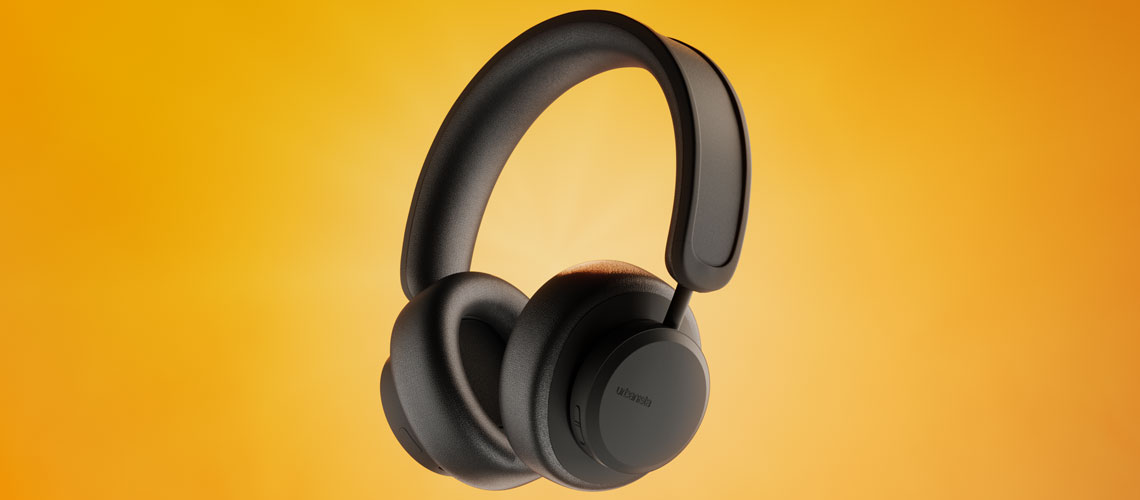
Published
- Sustainability
- Trends
- Tech
Solar cells from Sweden’s Exeger – soon in a headset near you
Imagine photovoltaic cells that can be charged through indoor lighting, bent any which way, and look like leather, fabric or even brushed steel? And that can be integrated into headsets, remote controls and even your cellphone?
Swedish tech company Exeger aims to build a new, large export business on a patented material that can achieve all of this. EKN is a part of the financing solution.
“We have invented, patented, developed and manufactured Powerfoyle – the name of the material – here in Stockholm. In creating a new Swedish industry, we are ready for the next step by the construction of a new production facility that will increase the production capacity tenfold,” says Giovanni Fili, CEO of Exeger.
When hearing about photovoltaic cells, most people probably think about large solar parks or 100 sqm solar panels mounted on roofs of buildings. But Exeger’s Powerfoyle is something completely different, as it is developed to charge common electronic devices by using only a few square centimeters of photovoltaic material – indoors as well as outside.
“Our photovoltaic cells are unique in many ways, partly because they may be charged through any available light, natural as well as artificial. This means it can be used on devices indoors, thus offering what can be described as wireless electricity,” says Fili.
Global tech companies are customers
The possibility of bending and producing the material in different designs allows the material to be integrated into virtually any consumer device that requires power. Consequently, Exeger’s sales process involves cooperation with electronics manufacturers.
“After twelve years, we have finally arrived at the commercialization stage, with two product launches coming up. Powerfoyle will be integrated into a helmet from POC and into a wireless headset from Urbanista. The headphones will never need to be recharged and offer unlimited and sustainable usage.
All of Exeger’s production is being exported, primarily to Asia, where the bulk of the global manufacturing industry is located. The world’s leading tech and consumer goods companies are on the customer list, and there is no shortage of interest, notes Fili.
“We have a large inflow of customers, but the process is time-consuming. We begin by looking at how we can improve the end-user experience with Powerfoyle, how big the market potential is, how the integration can be done, and whether the company’s values are aligned with Exeger’s. If we enter into a partnership we develop a prototype together, after which we sign a deal for delivery of our photovoltaic cells.”
EKN covers 80 percent of the bank’s risk
Exeger’s cooperation with EKN started years ago when the company first consulted EKN for advice and later developed a plan to meet financing needs.
“Once we needed funding, EKN was already on board. Their advice has also required us to think and rise to the next level, which has been very valuable.”
When Exeger needed funding for the new large production facility in Stockholm, EKN stepped in and shared the risk with the bank.
“EKN covers 80 percent of the bank’s risk through a Working Capital Credit Guarantee. Having EKN on board, we didn’t even try to secure the funding on our own since it’s obvious that the possibilities of getting help from the bank was that much larger with the support of EKN.”
Now, Exeger is looking forward. Their key patent landed Giovanni Fili and Henrik Lindström, PhD, nominations as Inventor of the Year, awarded by the European Patent Office. Also, a string of new products are about to hit the market.
”Soon the first self-charging wireless headphones and the first self-charging helmet will reach the store shelves, and there is more to come. We are in the process of setting a new standard for consumer electronics. Bluetooth is ubiquitous today, and that’s how we view Powerfoyle’s journey – as a technology that no-one wants to do without once they have started using it. That’s what we call irreversible tech,” Fili concludes.
